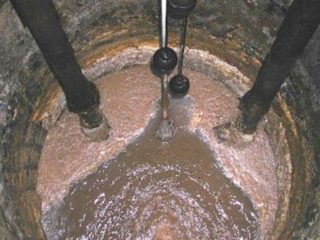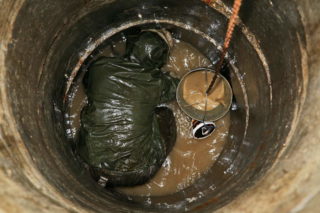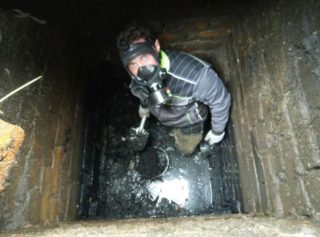The efficient operation of the sewage system depends on the fullness of the cesspool. Correct design guarantees operation without additional maintenance for years. But sooner or later, moments come when the pit begins to fill up quickly. For a short-term solution to the problem, they use the services of sewers and clean the sewers.
The real difficulty comes when filling takes place over a period of several weeks. It is too expensive to call in cleaning machines and specialists, so the root of the problem must be addressed. Below are the main factors causing the pit to fill, how to fix the problem, and tips for prevention.
Why does the pit fill up fast
The natural functioning of the reservoir implies a long-term operation of the sewage system without additional interventions. Only occasionally is it necessary to pump out feces and sewage using a sewer machine. The regularity of the procedure is determined by the frequency of use of the sewage system. When the pit begins to clog quickly, the following symptoms appear:
- there is a bad smell and stench on the site even if the tank is tightly closed;
- water slowly flows into the sewer pipe;
- fat and fecal deposits appear on the walls of the structure;
- the frequency of calling specialists for pumping out increases.
There are five main features that affect the rate of filling the pit:
- The presence of silt at the bottom of the structure... The more it is, the worse the natural release from fluid. The sludge must be cleaned periodically or chemicals must be used to promote its decomposition.
- Accumulation of debris and sediment... The more sewage is in the pit, the less the efficiency of the structure. Periodic cleaning of the bottom and walls is required, including a complete rinsing of the tank.
- Small volume... It is difficult to imagine the level of sewage waste without technical calculations and engineering design. Determining the volume of the container by eye or according to the recommendations of acquaintances, people often face problems in the future.
- Functional impairment... If there is intense groundwater under the bottom of the pit, this regularly causes the reservoir to be filled and the accumulated sewage wetted. The drain will not work properly.
- Freezing of drains... The most common reason for fast filling is encountered during the winter season. To solve the problem, it is necessary to improve the thermal insulation of the structure.
Methods for solving the problem
Technical cleaning... The walls and bottom of the pit become covered with silt over time, despite all preventive measures.To restore the outflow of water, you need to seek help from professional flushers or buy a special pump for self-pumping of fluid. A few recommendations:
- Before starting pumping, it is necessary to liquefy the contents of the pit, for which ordinary water is poured into it.
- After cleaning from the contents, the tank must be washed. For this, water is used, followed by pumping out. The procedure, if necessary, is repeated several times until the pit is visually put in order.
After that, it is necessary to test the operability of the sewage system and take preventive measures to slow down the pollution process. As for the pumped out sewage, they are placed in a specially dug pit or in a reservoir, which is then taken away from the site for disposal.
Biologics do an excellent job with silting up and are a prophylactic agent. They also prevent the reservoir from flooding and increase the service life of the sewerage system without additional intervention. Among the shortcomings, the temperature requirements are noted - not lower than zero and up to 40 degrees, the need to maintain the level of microorganisms, the negative effect of bleach, washing powders and other detergents.
Chemical substances... Thanks to the chemical composition, it is possible to cope with the problem of overflow and siltation of the pit, as well as eliminate the unpleasant odor. Unlike biological products, they are resistant to temperature changes and are inapplicable only when the reservoir is frozen.
You need to understand the composition of chemicals. Some of them have a negative impact on the environment, including products with ammonia and formaldehydes. For domestic use, nitrate oxidants are recommended, which are harmless to living organisms. The product of their oxidation is also used as a soil fertilizer.
In the cold season, when the contents of the pit freeze under the influence of low temperatures, it is required defrosting the tank. The problem is often observed in cold regions, as well as with poor thermal insulation of the structure. Frozen slurry reduces drainage efficiency to zero. For prophylaxis, an extension cord for 20-30 meters is needed to get from the nearest outlet to the pit, a copper wire designed for a power of 2 kW, as well as a metal pin. Step by step instructions for defrosting:
- Drive a pin into the center of the frozen waste.
- Fix the copper wire to the metal base.
- Connect the other end to an electrical plug.
- Switch on the mains voltage.
The thawing rate depends on the degree of freezing of the waste. If the cold has just come, a day is enough to see the result. When a thick layer of ice has formed, you must wait up to 48 hours. The pit will return to its normal state, the natural outflow of fluid and the release of the reservoir will begin. After that, remove the heating element, after turning off the voltage.
Remember the safety precautions when working with electricity. It is worth installing, removing the copper conductor only when the mains voltage is off. If possible, work should be carried out in rubber boots and special gloves.
The solution to the remaining problems is associated with the design features of the tank. If possible, it is necessary to re-equip, increase the volume or change the location of the pit. Otherwise, you will have to regularly use the services of sewers.
Measures to prevent this problem in the future
- Rinse the pit regularly under strong pressure, at least once every two months. The liquid will go into the ground, but it will clear the walls of the blockages.
- Use biologics during the warmer months to reduce solid waste. As a result, the pit will become less susceptible to silt accumulation.
- Dumping content on time is an important consideration as excessive waste build-up contributes to future problems.
- Insulate the pit or use a heat-conducting wire. The ideal option is to improve the thermal insulation of the structure. In case of regular problems with freezing of waste in winter, you can lay an insulated heat cable in the tank, which will allow you to heat the frozen waste without additional action.
Alternatively, additional holes are created on the site and connected with pipes. This increases the overall capacity and reduces sewerage problems.












